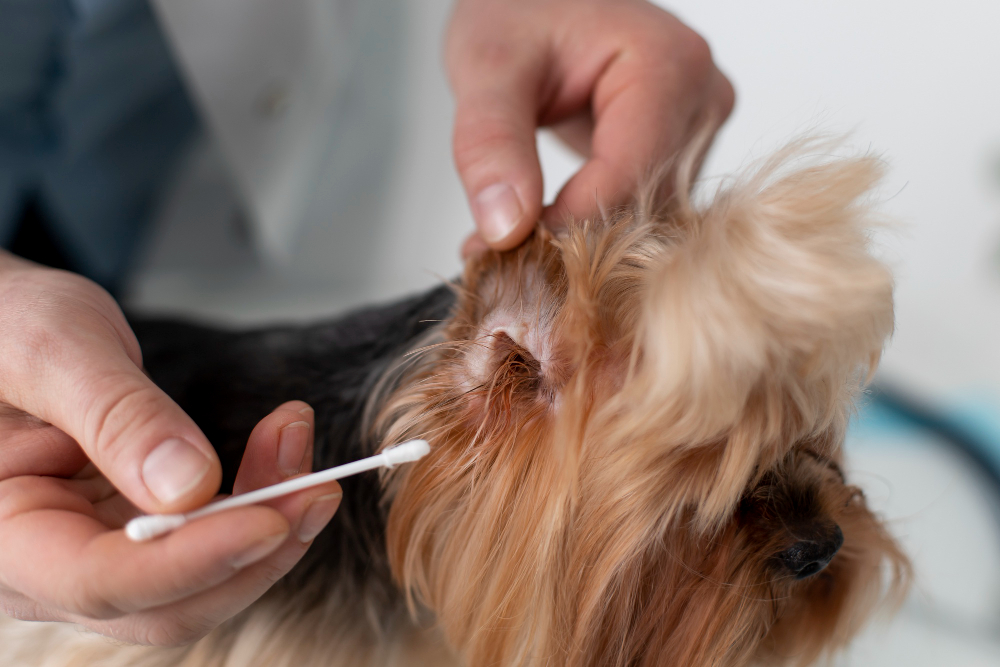
All dog lovers know how high-maintenance these furry pals are! They can be total bundles of joy, but some health issues they are prone to can become such a nuisance. Among these, ear problems can be real head-scratchers.
Two of our canine companions' most common ear diseases are yeast infections and mites. They might sound similar, but trust me, they're as different as cats and dogs – pun intended!
So, let's discover together what the two diseases are, their differences, and how you can treat them.
Dog Ear Yeast Infections: What Are They?
Dog ear infections are also known as otomycosis or canine otitis externa. They occur when a yeast-like fungus, primarily Malassezia, completely occupies the ears.
The most common reason for a dog's ear yeast infection is an abundance of moisture in the ear. This condition usually starts in the outer ear canal called otitis externa.
However, if it is not treated in time, it can spread to the middle ear canal, referred to as otitis media. If the ear infections get even more serious, then the inner ear, known as otitis interna, is also not spared.
This type of fungus is naturally present in small amounts in a dog's ear but can increase rapidly. This can then lead to an infection when the conditions become favorable. These favorable conditions include excessive moisture, allergies, or a weakened immune system as they catalyze the overgrowth of yeast in the ear canal.
Symptoms of Dog Ear Yeast Infection
Now that you've learned what a dog ear yeast infection is, you must be wondering how to detect it in case your dog gets one. It is also essential to identify these ear infections early so they don't spread and become damaging to your pet.
Some of the symptoms of a dog ear yeast infection include;
- Itching and scratching of the ear
- Redness and inflammation in the ear canals
- Hair loss on the outer ear
- Hyperpigmentation
- Foul-smelling discharge from the ear
- Head tilting or shaking
- Pain or discomfort on touching the ear
- Scabs and sores around the ear
In more severe cases, there may be hearing loss or balance issues.
Ear Mites: What Are They?
Ear mites are microscopic parasites that can infest a dog's ear canal. These tiny pests, also known as Otodectes cynotis, are highly contagious. They can easily spread from one dog to another through direct contact.
Ear mites love to feed on the oils and ear wax present in the ear, which causes irritation and inflammation. They live by feeding on the dead skin cells that are shed naturally by the inner ear lining.
These mites are too tiny to be seen with the naked eye, but your vet has the tools to detect them.
Symptoms of Ear Mites in Dogs
While you may not be able to see ear mites with the naked eye, specific symptoms can make it obvious that your dog indeed has ear mites.
These symptoms include;
- Intense itching, often leading to excessive scratching.
- Dark, crumbly discharge resembling coffee grounds in the ear.
- Redness and inflammation of the ear canal.
- Head shaking or tilting.
- Secondary bacterial infections may develop if left untreated.
Some of the symptoms might seem similar to those of a yeast infection. The main difference is the coffee-like discharge caused by the ear mites.
How Do Dog Gets Mites?
Ear mites tend to be more prevalent in puppies due to their less developed immune systems. Dogs usually get mites from other animals, in particular cats. These mites can be contracted while playing with other dogs and animals.
This happens mostly in settings where dogs come into close contact with each other. These settings include kennels, shelters, or multi-dog households.
The mites can also infest other animals, including cats and ferrets.
Dog Ear Yeast Infection vs Ear Mites: What Is the Main Difference?
While both dog ear infections and ear mites can lead to discomfort and similar symptoms, they differ in their underlying causes and treatments.
The main differences include the following;
- Cause: Dog ear yeast infections are mainly caused by an overgrowth of yeast-like fungi. Conversely, dog ear mites are caused by tiny parasitic mites. Moreover, ear mites are more prevalent in puppies than in adult dogs. Still, yeast infections can happen in both puppies and adult dogs.
- Contagiousness: Ear mites are highly contagious and can easily spread from one dog to another. Ear infections, including yeast infections, are not contagious.
- Discharge: The discharge associated with ear mites is often dark, crumbly, and resembles coffee grounds. But with ear yeast infections, the ears expel a foul-smelling discharge that is more liquid in nature.
- Treatment: Ear infections are often caused by underlying issues such as allergies, so the treatment is usually done by first addressing them. Antifungal medications are used to treat ear infections. However, ear mites require specific anti-parasitic treatments to eliminate the mites.
How to Treat Dog Ear Yeast Infections?

Treating a dog ear yeast infection involves a combination of at-home care and veterinary intervention. Here are the steps to effectively manage this condition:
- Consult a Veterinarian: Do not start medication before getting a proper diagnosis from your vet. Your vet may recommend a thorough ear examination and may take a swab of the ear discharge for analysis.
- Cleaning the Ear: Clean your dog's ear canal with an ear swab or cotton ball. Be gentle to avoid causing further irritation.
- Medication: Antifungal ear drops or ointments are used to treat the yeast infection in the dog's ear.
- Address Underlying Causes: If your dog has previous allergies that might have contributed to ear infections, then you should discuss it with your vet and get a treatment plan for it. This may involve dietary changes or allergy management.
You can also use home remedies to treat dog ear yeast infections. You can even use these to clean dog's ears at home. These remedies include;
- Apple cider vinegar: Mix half part apple cider vinegar and half part water and spray it in your dog's ears regularly. Use cotton balls to gently wipe the discharge and spread the mixture evenly.
- Calendula Oil: Calendula oil has healing properties. It helps minimize inflammation and swelling in the ears. Buy herbal calendula in tincture form and use 5 to 10 drops of it with water. Use a cotton ball to gently spread it in the dog's ears.
- Avoid processed foods: Avoid giving your dog a diet that contains carbohydrates and sugar, as they promote the growth of yeast. Instead, give a raw-meat-based diet to your dog, which will help with the ear infection.
Treating Ear Mites in Dogs
Dog ear mites are very contagious and can cause severe discomfort for your dog. Follow the steps to treat ear mite treatment.
- Consult your vet: The first step to treat ear mites is getting a proper diagnosis from your vet. Your vet may prescribe anti-parasitic medications in the form of topical ear drops, oral medications, or both. If you don't want to use over-the-counter drugs, you can always opt for home remedies.
- Cleaning the Ears: You should regularly clean your dog's ears to avoid ear infections and mites. You can use vet-recommended ear drops or even olive oil to clean your dog's ears. Apple cider vinegar and aloe vera are also used to clean the ears.
- Environmental Clean-Up: Mites are tiny parasites that can quickly spread all over your home, so you must clean your entire home, including furniture, to prevent re-infestation.
- Preventive Measures: If you know any other pets in your surroundings have ear mites, keep your dog away. Mites are extremely contagious, so they spread very quickly.
Final Words
In conclusion, yeast infections and ear mites are common ear problems affecting our beloved pets. While the symptoms may be similar, knowing the differences between the two conditions is essential to provide appropriate treatment.



















